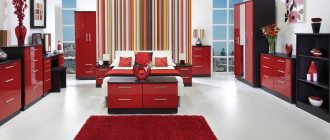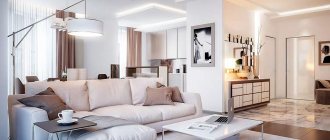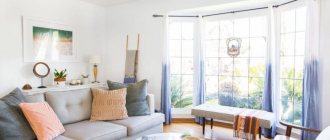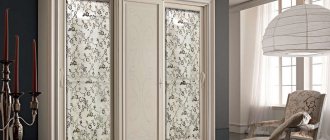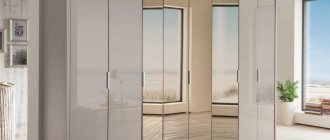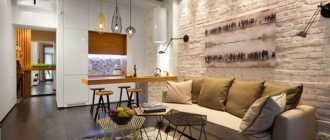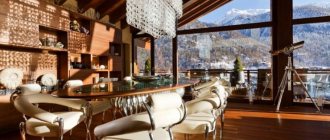The living room is a very important room in the house, because it is where we receive guests, spend evening time with our beloved family in front of the TV or playing an exciting board game. Of course, we all want to make this place one of the most comfortable and favorite rooms in our home. At the planning stage of a design project, we think about the color of the curtains for the windows, the shade of the walls, flooring options and finishing materials, and we also definitely consider what furniture will be installed in our living room and in what places it will be located.
One of the main pieces of furniture for the living room is a wardrobe that can combine many functions.
In today's article we will talk about a wardrobe in the living room, beautiful design options for different interiors of the room. Which one is better to choose, how not to make a mistake with the location and design - we will analyze all the features, advantages and disadvantages of this type of furniture.
Purpose
Book - has hinged glazed (upper part) and blind (lower part) doors. Expensive books and albums are usually stored in the upper part, and more modest magazines, brochures, newspaper files, and notebooks are stored in the lower part.
There are two types of closed bookcases:
- single-row – books are placed in 1 “layer”. Such cabinets provide easy access to books and are quite compact, but not too spacious;
- double-row – books stand in 2 and 2.5 “layers”. This option holds many more books and makes better use of room space. At the same time, access to the necessary book can be difficult, and you can’t install a double-row cabinet in a narrow corridor.
A shelving unit is an open bookcase where books for daily use (dictionaries, reference books, encyclopedias, magazines) are stored.
Clothes room - differs from its office counterpart in that it has shelves and drawers for storing linen and other items of clothing. The wardrobe is equipped with several crossbars: for short items (one or two rods) and for long items (raincoats, coats, dresses). The modern wardrobe is usually found in the form of a sliding wardrobe.
There are two options for clothing arrangement:
- end rails - clothes hang parallel to the closet door. This solution is found in narrow cabinets.
- longitudinal crossbars - clothes hang perpendicular to the closet door. This option is used for cabinets with a depth of 65 cm or more.
Location
Freestanding (cabinet) - rests on the body, does not have a rigid “attachment” to the wall, floor, ceiling, and, if necessary, can be moved to another location.
Built-in - built directly into the wall of the room, which eliminates its rearrangement. Such a cabinet has a frame rigidly attached to the floor, walls and ceiling. The built-in model will fit perfectly into places where cabinet furniture cannot be placed, but it is more difficult to install. Sliding wardrobes are often built-in. This model is the best option for a wardrobe in the living room.
Facades - how they are arranged, types of decor
The front of the wardrobe in the living room is its face. It is the appearance of the doors that determines the style and beauty of the cabinet.
An interesting and modern type of facades are paneled or framed. The essence of the design is quite simple and it consists of a frame into which the filling is inserted. Both the frame itself and the panel can be made of various materials, which increases the decorative potential of this type of facade. Solid wood, glass, veneer, chipboard, plywood - this is only the main part of the filling materials.
A glass or mirror facade can be a wonderful decoration for a wardrobe. Colored glass or a mirror decorated with a pattern can become a real highlight of the living room. In addition, such doors are made from special types of glass, and they fully meet all operational requirements.
Front designs for sliding wardrobes come in two types: solid and paneled. Solid fronts for sliding wardrobes are not as popular as frame ones, but are more practical and durable. Made from a solid wooden slab, they are more resistant to moisture and mechanical damage. Despite the fact that the wooden facade itself looks expensive and beautiful, solid slabs are decorated with decorative inserts and carved patterns.
Both for the functional side and for visual appeal, an important point is the selection of the correct number of cabinet door leaves. Ideally, their number should be at least two and no more than four. But if it is necessary to fit into the width of the opening, their number is increased.
Frame
Single -cabinet is a one-piece cabinet that does not involve combining elements into a new design.
Modular - allows you to add new blocks (modules) or swap sections without reducing its reliability. For example, you can make 6 or 5 door cabinets. Another option is a combination of closed modules and open sections.
The modular body allows you to create symmetrical and asymmetrical designs depending on the living room interior or the user’s desires.
Design
Closed - consists of drawers or shelves with doors. The doors themselves can be either solid or glass (for monitoring stored items). Such a cabinet, equipped with locks, protects documents and belongings from unauthorized persons and dust, but will be more expensive. Wardrobes are closed.
Open (rack) - consists of shelves, and the doors and back wall are (sometimes) missing. In the latter case, the wall is replaced by an office wall. The open version is cheaper than the closed model, but provides quick access to things and documents. The disadvantage of an open cabinet is the lack of protection of the contents from strangers and dust.
Important: with the help of such furniture you can divide the room into zones, for example, in a one-room apartment.
Combined - combines open and closed sections. For example, open or glazed shelves (upper part) and drawers with sliding or hinged doors (lower part). Due to their versatility, combined cabinets are most common.
Important: a combined cabinet can be used to store documents and things, which will save money and space in the room. In this case, the optimal distribution of items will be as follows:
- open sections - souvenirs, dishes, books, photographs;
- closed sections - clothes, linen, household appliances, various equipment, documents.
Internal filling of cabinets
It’s not enough to choose a cabinet that looks perfectly in harmony with the surrounding space. Internal filling plays a key role in the overall functionality of the storage area. The standard layout includes shelves, a hanging bar and several drawers. But, before purchasing, you should carefully evaluate the number and type of things that you plan to place in the closet.
If the structure is planned to be used as a universal storage area, then care should be taken to have shelves for shoes, mezzanines for bed linen and a comfortable area for bulky outerwear. Conventionally, the closet is divided into 3 levels:
- lower – storage of boxes with shoes, bags;
- medium – for everyday items, underwear, home clothes, bedding;
- the top one is intended for seasonal wardrobe items, blankets, rugs, pillows.
Based on the convenient arrangement of things, you can place any number of everyday items in the closet and at the same time provide exceptional comfort of use.
Form
Linear (rectangular) is the classic version that is most common. A linear cabinet can be placed almost anywhere.
U-shaped - two halves of the cabinet are placed on both sides of the door and connected by the section located underneath it (mezzanine). This type of cabinet takes up a significant amount of space.
L-shaped (corner) – allows you to fit the cabinet into a corner, thereby saving office space. On the other hand, the corner model cannot be placed anywhere. The optimal solution for small spaces.
Popular models
Cabinets are designed to store various things. Based on its purpose, fashion designers have developed several varieties of this piece of furniture. The most common cabinet designs are:
- Corpus. Traditional products that are not tied to one place and can be rearranged or moved to another room if necessary. As a rule, cabinet models are quite impressive in size, although there are also compact examples.
- Modular. These are modern and very comfortable designs. They are made up of individual parts, which allows you to change the configuration at the request of the owner. You can add new elements and expand functionality due to more efficient distribution of the useful volume of the cabinet. Such solutions are not suitable for every interior style.
- Built-in wardrobes. These structures are installed between two opposite walls, cutting off some part of the room. They are usually large in size. If there is a niche, the cabinet is placed in it and you get a more neat surface with a lot of useful features. Such models can have different design options, match any style, and be built into the entire wall of the room. This allows the cabinet to harmoniously fit into any room, complement and highlight the features of the interior. Large mirrors are often installed on the doors of such designs, which visually expands the area of the room, making it more spacious and brighter. Typically, built-in products are made to order. This makes it possible to use the allocated space with maximum efficiency and obtain comfortable and functional pieces of furniture.
- Closet. A practical and convenient option, one of the types of built-in structures. Its special feature is large doors that move sideways along guides. Thanks to this, there is no need to leave space for the doors to move, as is the case with swing options. Usually mirrors are installed on canvases, which allows you to visually expand the area of the hall. The only drawback of such cabinets is the lack of stylistic options for the design of the facade.
- Showcase. This is a type of cabinet with glazed doors. For such products, the glass is left transparent, which allows you to see the contents. This type of cabinet serves as an excellent decoration for the room, but at the same time requires order and cleanliness inside.
- Suspension. These structures are mounted on walls using a hinged method. The size of such products is relatively small. Typically, hanging cabinets serve as a complement to sets - walls, slides.
- Pencil case. The narrow and relatively high body allows you to accommodate a large number of things or dishes. Convenient for rooms where there are small partitions that do not allow the installation of wide models.
- Combined. This is a multifunctional furniture set, which is commonly called a wall. This type is familiar to everyone. In Soviet times, the wall was an indicator of a family’s wealth. Today, such samples have somewhat lost their attractiveness in the eyes of people, but have not yet disappeared.
- Book. A type of display cabinet with transparent walls. Another remnant of the Soviet era, stylish and highly appreciated by people reading. For owners of large libraries, such a cabinet is useless, since it can accommodate a relatively small number of books.
- Posudny. It is also a type of showcase. Often there are cabinets with blank doors. Such a product is installed in the hall infrequently, usually when there is absolutely nowhere to attach it.
It is also necessary to mention corner models. This is a convenient option for a hall in a small apartment. They are designed for installation in a corner formed by two adjacent walls. There are rooms where the furniture is divided into parts by doorways. Installing a corner cabinet can partially solve the problem of lack of space.
How to choose corner furniture for the living room, popular designs
Hull
Modular
Built-in
Closet
Showcase
Suspension
Pencil case
Combined
Book
Posudny
Angular
Doors
Hinged doors - doors open outward and are mounted on hinges. This option is most common, but when opening it requires free space.
Sliding (“coupe”) doors open to the side: they ride on rollers along guides. This opening method does not require additional space, but it does block access to other sections of the wardrobe. It is convenient to work with such a model even in cramped conditions. Dust and small objects stuck in the door grooves make them difficult to move.
There are two options for guides:
- lower – designed for low and light doors (doors for mezzanine);
- top – used for high and heavy doors (mirror doors). In addition to the ability to withstand significant loads, dust does not accumulate on them, small objects and pet hair do not fall on them. Doors on top tracks are more durable and easier to open.
Folding (“accordion”) is a middle option between the previous methods: the doors open outward, while folding in half. The “accordion” loses to the “compartment” in saving room space, but wins in ergonomics: it provides access to various parts of the closet.
With a roller shutter - the door goes down from top to bottom (like a blind). Like the sliding method, this option does not take up space in the room, but provides access to all parts of the cabinet.
Hinged - found in the lower sections of some tall cabinets.
Types of cabinets in the house by doors and opening system
Varieties of cabinet doors allow you to install them in different rooms, even the smallest ones. According to the opening system, doors can be of three types:
- Sliding - they are often installed on sliding wardrobes. The door leaf, in this case, moves along the guide rails using rollers. This saves space around the structure.
- Hinged doors are classic doors that open horizontally.
- Folding - the doors operate using the same mechanism as sliding models, but the leaf not only slides to the side, but also folds like an accordion.
The number of doors can reach five. The most popular types of wardrobes are models with 2 or 3 doors.
Material
Chipboard and MDF - combine affordable price and acceptable quality. At the same time, a cabinet made of chipboard will cost less, but is more toxic than a similar product made of MDF.
Important: pay attention to the environmental class labeling (E1; E2...). The safety cabinet is class E1.
For bathrooms and other rooms with high humidity, moisture-resistant chipboards should be used.
Wood is an environmentally friendly, durable, beautiful, but expensive material. The price of the cabinet depends on the type of wood. Office furniture made of wood usually looks more massive than its counterparts made of chipboard and MDF. It should be remembered that in rooms with high humidity, wood that is not coated with special compounds can swell, and in very dry rooms it can dry out.
Important: different types of wood have different degrees of hardness. The softest species are pine and spruce, followed by beech, oak, hornbeam, cherry, and birch. The most durable are walnut, ash and Canadian maple. The complexity of processing, and therefore the final price of furniture, depends on the degree of hardness: cheap softwoods are easy to process, hard ones are much more difficult.
Rattan is a type of wood from which bent furniture is made. Whatnots are often made from rattan. Rattan furniture will fit perfectly into a “rustic” interior.
Metal (stainless steel) is the most durable and heaviest material. The metal cabinet can hold a large volume of documents. It is resistant not only to mechanical stress (including burglary), but also fireproof, and is also not afraid of humidity and temperature changes.
The appearance of metal cabinets is usually modest, so they are not used in the living room.
Composite - usually consists of metal (frame) and laminated chipboard (panels). This cabinet combines durability and attractive appearance. Sliding wardrobes are composite.
Important: the frame of the sliding wardrobe is made of steel or aluminum profile. Steel compares favorably with aluminum in its rigidity and strength: such a frame will last longer.
Glass (shelves and doors) is impressive in appearance and allows you to see the contents of the cabinet. It must be remembered that glass is too fragile and with intensive use the risk of damage to such a cabinet increases significantly. The vast majority of living room cabinets have glazed doors (display case, sideboard, sideboard, extension).
Glass can be transparent, tinted or frosted, and can also be made in the form of stained glass and mirrors. There are glasses with intricate patterns and etched designs. This material goes well with both wood and chromed metal or plastic.
Important: rollers in cabinets with sliding doors are made of plastic and metal. It is better to choose a model with more expensive metal rollers, as they are much more durable.
In wardrobes, drawers and shelves are made of wood/chipboard or plastic. There are more durable combined versions of wood and metal - for drawers in which it is supposed to store not only linen and clothes.
Coloring and design of the facade
The vast majority of cabinet furniture has a natural wood color. There are dark or light models, but all of them are colored in natural tones with imitation texture. This is determined by tradition - wood is considered the base material from which furniture is made. However, there are models whose finish is a different color. It is usually white with (or without) gold-plated decorative elements. This option appeared in the palaces of the European nobility, where dark cabinets created a too dull, depressing atmosphere.
Many design options for furniture facades have been developed. They can be made in different styles:
- Classic. Made according to the traditional “binding-panel” pattern.
- Modern. They are either simple and discreet canvases of a homogeneous type, or combined with inserts from other materials (glass, mirrors, plastic or metal moldings, and so on).
In classical and neoclassical styles, rectangular cabinets in restrained shades and made of wood are more often used. The facades can be decorated with mirrors, forged and carved decor. Minimalism involves the use of more laconic models with blind doors. In high-tech you can find cabinets with facades covered with varnish, doors decorated with glass, leather or plastic inserts. Provence is characterized by furniture decorated with floral patterns and sandblasting.
The nuances of choosing and placing a corner cabinet in the living room, useful tips
The interior of a room consists of many elements that should fit together as closely as possible, forming a coherent, harmonious image of the room. Therefore, the style and color of the cabinet is no less important than its size or functionality. The more expressive the style of the room’s design, the more strictly you should choose the appearance of the furniture.
Classical
Modern
Minimalism
High tech
Provence
Any doors can be used in closets: sliding, hinged, folding. Leather, carved elements, textiles, and mirrors are used for their decoration. The swing models use original handles. Mirror and glass facades are decorated with colored stained glass, sandblasting, photo printing, and so on. For decorative fittings, not only different types of handles are used, but also various edging materials.
You should not try to combine Hi-Tech and classicism in one room.
Sliding doors
Swing
Folding
Size
When choosing a closet for the living room, first of all, the free space of the room is taken into account. Ideally, the closet should occupy a minimum of space (this is especially important for an office) and not interfere with movement. At the same time, it should accommodate a maximum of items. The optimal choice would be a model that achieves a balance between size and capacity.
The size of a living room closet also depends on the number of items that are supposed to be stored in it. When choosing models for storing outerwear, you should take into account the number of family members. To avoid overloading the cabinet, it is better to purchase several models.
Important: if you need to store a large number of items, many of which are rarely used, then the cabinet can be supplemented with mezzanines. Although bulky, it is a smart alternative to purchasing a new cabinet.
Varieties
The interior of the living room must certainly be comfortable for each family member, so when choosing furniture it is important to take into account the needs of both children and adults. The following cabinet configurations are most relevant in the living room. Based on the specifics of installation, cabinets are distinguished:
- suspended - do not have supports, as they are mounted on the wall surface. In recent years, this has been a very popular subtype of cabinets for living rooms, because such items allow you to rationally use the space of a small room. They do not visually burden a small room, allowing you to use the internal contents of the product as rationally as possible without compromising the space. The main thing is to choose reliable fastenings and avoid mistakes during the installation of such structures;
- stationary floor - rest on legs. Such furniture can be easily moved, and installation in place does not require drilling into the walls.
Suspension
Stationary
Based on their purpose, there are lockers:
- book - used for storing books and magazines;
- wardrobe - used to store a person’s personal wardrobe;
- racks do not have doors, so they are relevant for arranging decorative accessories.
It is convenient to zone the living room space using cabinets for any purpose, if their design is successfully combined with the style of decoration on the walls. But you should refuse to replace the closet with a chest or chest of drawers. Such interior items will not be as functional and will not allow for the placement of a large number of clothes, accessories, and personal wardrobe items of the home owners. Especially if the room is not spacious.
Book
Clothes
Rack
Style
Classic – the cabinet is distinguished by its rigor and regularity of form, and restraint of colors. It is often decorated with carvings. Materials: valuable wood species (walnut, cherry).
Country - a roughly processed massive cabinet in natural shades - light and dark. The cabinet is not polished or varnished, but can be “aged.” Materials: simple wood (primarily pine).
Baroque/Rococo - characterized by the dominance of curvilinear forms and a wealth of decorative design. Colors: pastel (light green, light pink, light yellow). A cabinet in the Baroque style is more massive, while a similar model in the Rococo style is more elegant. Materials: rosewood, dark walnut, rosewood and other valuable woods.
Modern – the cabinet has smooth outlines and asymmetrical shapes, and is distinguished by complex floral patterns. Colors: pastel, light green, light yellow. Materials: valuable wood, sometimes combined with glass and plastic.
high-tech and minimalist styles are also popular .
Equipment (wardrobe)
A pantograph is a wardrobe “elevator”, consisting of a crossbar attached to movable joints and a handle with which the bar is tilted to the desired level. This “lift” is very convenient for placing clothes at the top of the closet.
Turbo hanger – used for storing ties (up to 70 units). Equipped with a motor for rotating the carousel and lighting.
Illumination makes it easier to use the closet in the dark: to find the thing you need, you don’t need to turn on the light in the room. Lighting can be external (on cornices) and internal (on shelf panels).
A mirror - in addition to its main function, visually expands the space of the room. The mirror can occupy the entire area of the cabinet doors or part of them. On the other hand, the mirror collects fingerprints well and attracts dust - such a surface requires regular maintenance.
What are the best doors to choose for a closet?
The beauty of the cabinet is determined by the facades. They are made from laminated chipboard or MDF, which is painted and varnished, veneered or covered with fabric. MDF provides more opportunities for decorating the facade: using inserts and milling handles, for example. It will not be possible to do this in material thinner than 22 millimeters, and a slab of such thickness is quite heavy. But weight is not a problem if at least five hinges are installed. A soft-close feature is standard on modern cabinetry, but it's best to make sure it's included before purchasing.
Important! Pay attention to the gaps between the facades. High-quality hinges require a distance between doors of 2-3 mm. Large gaps look bad and allow more dust into the cabinet (or out of the cabinet, depending on who you choose). To reduce dust, a strip is used (a strip of soft plastic that closes the gap between the facades).
The cover closes the gap between the facades and protects from dust.
Adviсe
- First, you should measure the space where you plan to install the cabinet. Knowing the parameters of width, length and height, it is much easier to choose the appropriate model.
- It is better to purchase quality products from well-known brands than a cheaper option that is questionable in terms of quality and safety. A high-quality cabinet has an appropriate certificate and a hygienic certificate.
- It is necessary to make sure that there are no defects in the cabinet (scratches, chips, deformations). This is especially important when choosing products for the bathroom, since moisture can penetrate through cracks or holes, which will lead to rapid damage to the cabinet.
- It is worth checking the reliability of connections, retractable mechanisms and fittings (hinges, ties, guides, handles, etc.). Doors should open freely and not creak. Make sure drawers close and open quietly and easily.
- It’s good if the cabinet is easy to assemble and disassemble. Such furniture will create fewer problems when moving.
- All surfaces of the cabinet must be polished, varnished or have an appropriate protective coating.
- The legs of the cabinet must be covered with a plinth - a strip that protects the space under the furniture from dust. The plinth is a decorative element and also often acts as a support and increases the rigidity of the model.
Designing a wardrobe for a nursery
Involve your child in this action, ask him what kind of wardrobe he wants to see in his room! The sliding wardrobe invented with his participation will be a joy for everyone! Believe me, joint construction will bring a lot of pleasure to you and your child! Both girls and boys involved in the process of designing a closet will be delighted with the variety of colors and materials when choosing the decor and filling of the closet, because a child’s imagination simply has no limits, the child will be delighted with the result of his work and, believe me, he will be happy to tidy up your room, putting all your things in their places in the closet. Reliable mechanisms will withstand any directed efforts during noisy games of large children's groups, and the wardrobe will serve as a place for a teenager to place all his fashionable things, as well as gadgets and textbooks.
Original design of a wardrobe for a children's room





